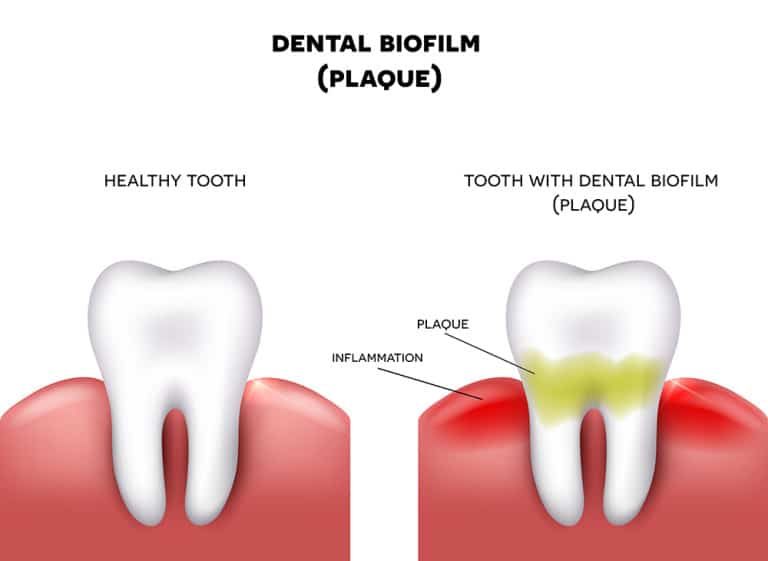Looking for the best way to keep your smile bright and your breath fresh between dental visits? It starts with daily plaque removal.
Plaque vs. Tartar
There’s something important that you need to know about cleaning your teeth: plaque and tartar are not the same thing.
Plaque is a soft biofilm that is a byproduct of the natural flora inside of your mouth. It forms after you’ve eaten food. A high intake of carbohydrates, sugars, or acidic foods can result in higher levels of plaque…which can mean more tooth decay and gum infections.
Tartar is calcified plaque. The rock-like substance gradually accumulates when plaque has been left undisturbed for approximately 24-hours. Slowly, layer upon layer, the tartar builds itself on the teeth and under the gums. It’s dangerous, because it can’t be removed with a toothbrush and floss, yet it harbors bacteria that lead to tooth loss. Only your hygienist or dentist can remove it.
As you may have guessed, the key is to remove plaque while it’s still soft…before you develop real problems!
Along Your Gums
The first area that plaque tends to collect is along your gumlines, or the “sulcus” as your dentist refers to it. This small pocket surrounds each tooth and allows biofilm to collect between meals and throughout the day.
To remove plaque thoroughly, angle your toothbrush toward your gumlines at about 45-degrees. Use gentle pressure (not too much) and make short back and forth sweeping movements on only one or two teeth at a time. Scrubbing too hard or making large sweeping movements can damage your gums or leave plaque behind due to the bristles being bent out of the way.
Between the Teeth
Expensive electronic toothbrushes can’t clean between your teeth, no matter how hard you try. The only thing that can is floss.
Floss physically disrupts plaque biofilm before it has a chance to calcify into tartar. The key is to floss daily before that calcification process takes place.
Wrap the string of floss around your middle fingers, and then use your thumb and forefinger to slip it between two teeth. Some people even tie the floss into a large circle, making it easier to hold and “rotate” as the string becomes soiled, letting you use a clean portion.
Gently wrap the floss in a “C” shape, against your tooth. Glide it slowly up and down the side of the tooth and down under the gum tissues. Don’t push too hard…just let it slip a few millimeters under your gingiva until it stops. Repeat this several times and then lower the floss and clean the adjacent tooth (taking care not to cut your gums.)
If your gums bleed, you may have gingivitis or gum disease. Continue flossing once a day for up to two weeks before expecting bleeding to go away. If it continues past this point, you need to see a dentist right away.
Hate Flossing? Try This Alternative
Water flossers are a great alternative to using conventional floss. Plus, they’re easy to use around your braces or under a bridge. Although they can be a little messy to use, with a little practice you can clean around your teeth without getting too much water everywhere. There are even designs that can be installed directly in your shower.
Visit Your Hygienist
Even the best brushing and flossing can leave behind areas of buildup in those hard-to-reach areas. People with great oral hygiene usually benefit from a dental cleaning every six months (more frequently if you’ve been battling gum disease.) The great news is that most dental insurance plans cover six-month cleanings in full, because of their preventive nature.
Keeping these appointments will keep buildup to a minimum so that it doesn’t have a head-start at triggering bone loss or periodontal disease.
“What About Dental Tools I Can Buy Online?”
Surprisingly, there are tools that look like real dental scalers, which you can buy online or even at the grocery store. They may not be as sharp or curved the right way, but some people like to use them to clean around fixed retainers or between their teeth.
Unfortunately, there’s risk of doing a lot of irreversible damage — like cutting your gums so they don’t grow back, or popping off a crown — and you won’t have anyone to blame but yourself. It’s best to leave these instruments to the experts.
You Can Afford to See a Dentist!
At AetnaDentalOffers.com we can help you find a dental discount plan that makes preventive care very affordable. Contact us today for details!
